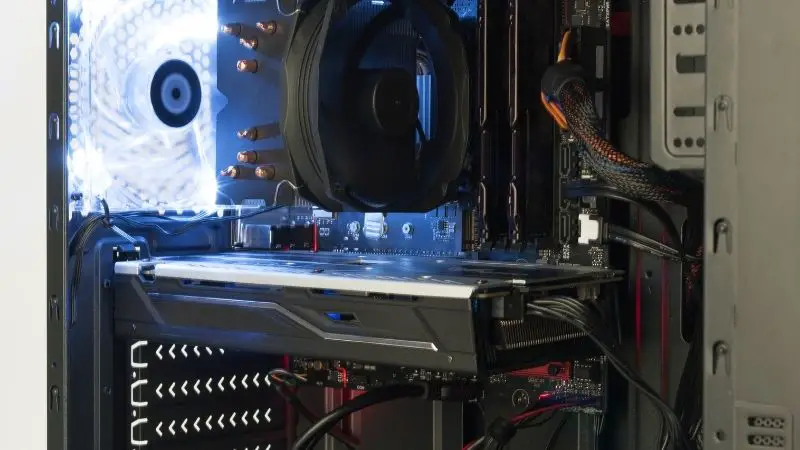What is the Difference between a Computer and a Monitor?
Never understood the difference between a computer and a monitor? You are not the only one. I worked 20 years as tech-support, and I can tell you that a high percentage of the employees were doing the same mistake. If I emailed them to ask their computer reference, maybe one third will reply with the monitor brand. Anyway, after reading this article, you’ll finally know the difference between both.
As a general rule, the computer is doing all the work and use a monitor to display the results for the user. The monitor has no intelligence, it’s just a peripheral for the computer. The storage, processor and memory are all inside the computer.
After this short introduction, we’ll see in details each component, and compare them side-by-side.
The Computer
Definition
A computer is a personal device designed for regular use at a single location on or near a desk or table due to its size and power requirements. The most common configuration has a case that houses the power supply, motherboard, disk storage; a keyboard and mouse for input; and a computer monitor, speakers, and, often, a printer for output.
Wikipedia
History
The first computer was the Hewlett Packard 9100A, presented in 1968. From that point forward, there were a large number of computers developed and delivered all over the world.
Early computers, similar to the first IBM Personal Computer, were encased in a “desktop case”, horizontally situated to have the display screen set on top to save space on the user’s desk area, although these cases were solid enough to support the heaviness of CRT displays that were very wide at that point. Throughout the 1990s, desktop cases turned out to be less common than the more-open tower cases that might be situated on the floor under or close to a desk instead of on a desk – occupying more space.

Among computer factors, desktop computers continue to be a primary step in the enterprise market yet have lost popularity among home purchasers. Computer makers and device retailers have responded by investing their designing and marketing resources towards laptops instead of desktop computers now.
Characteristics
Computers can be characterized into the following:
- Speed: A computer works with a lot higher speed compared with people while performing calculations.
- Accuracy: Computers perform estimations with 100% accuracy. Errors may happen because of data irregularity or incorrectness.
- Perseverance: A computer can perform a huge number of tasks or calculations with a similar consistency and accuracy.
- Flexibility: Flexibility refers to the ability of a computer to perform various types of tasks with the same precision and efficiency.
- Automation: The computer performs every one of the tasks naturally for example it performs tasks without manual efforts.
- Memory: A computer has built-in memory where it stores information. It also has secondary memory like CDs, pen drives, and so on, which are additionally used to store information.
You should also read: 4 Essential Differences Between a Computer and a PC
The Monitor
Definition
A computer monitor is an output device that displays information in pictorial form. A monitor usually comprises the visual display, circuitry, casing, and power supply.
Wikipedia
It has no CPU, no RAM, nothing that makes it anything over an advanced TV used for computers. The initial monitors for home computers were almost that – your home TV. The monitor is useless without a computer.
Types
The vast majority of people use computer monitors every day at work or home. And keeping in mind that these come in a variety of shapes, designs, and colors, they can likewise be classified into three major types.
CRT (Cathode Ray Tube) monitors
These monitors use CRT technology, which was used most usually in the manufacturing of TV screens. With these monitors, a stream of extraordinary high-energy electrons is used to frame pictures on a screen.
As they have currently vanished from the market over many years because display manufacturers transitioned their production lines from CRT 4:3 displays to LCD 16:9 widescreen displays to endure the progress to the advanced world widescreen TV of LEDs or LCDs.
LCD (Liquid Crystal Display) monitors
The LCD monitor includes perhaps one of the most cutting-edge technologies accessible today. Commonly, it comprises a layer of color or monochrome pixels arranged between several simple cathodes and two polarizing filters.

The benefits of LCD monitors include their conservative size which makes them lightweight. They additionally don’t burn through much power as CRT monitors and can be drained off of batteries which makes them ideal for desktops.
LED (Light Emitting Diodes) monitors
LED’s is one of the most recent advancements in the present market competing with LCDs and Plasma Monitors. These types of monitors are marginally bent or flat panel displays that use light-emitting diodes for backdrop illumination on the screen rather than cold cathode fluorescent (CCFL) for back-lighting.
The advantages of LEDs are that they produce pictures with higher contrast and striking colors as well as don’t have an adverse effect on the climate at the hour of disposing of. Likewise, the LEDs are stronger when compared to LCD and CRT Monitors.
Characteristics
Monitors can be classified into the following characteristics:
- Pixel: The term pixel is a reference to the image element. Pixels are the tiny dots that include a screen. Every pixel comprises red, green, and blue (RGB).
- Dot pitch: Dot pitch is the distance between pixels on the screen. A lower dot pitch number creates a better picture.
- Contrast Ratio: The contrast ratio is an estimation of the difference in intensity of light between the brightest point and the darkest point.
- Refresh rate: The standard old monitor refresh rate was 60 hertz (Hz) whereas the standard new refresh rate is 75 hertz (Hz).
Differences between Computer & Monitor
The monitor is the screen on which you see the information your computer is showing to you. While, a desktop computer is a container of different sizes, containing every one of the pieces and components that make up a computer. It is the CPU, the motherboard, the RAM, the hard drive(s), the video card, including the power supply.

The desktop on your computer is the main screen that is displayed on the monitor after you’ve completed booting your computer. It’s the point of access for every other program on your computer. Your desktop allows you to use the computer in an easy graphics interface – shown through the monitor. Simply put, the monitor allows you to see the desktop of your desktop computer. In general, there is no common ground between the two.
By the way, in the same category, there are also major differences between a computer and a PC that you need to know about. Click on the link to read this article.






